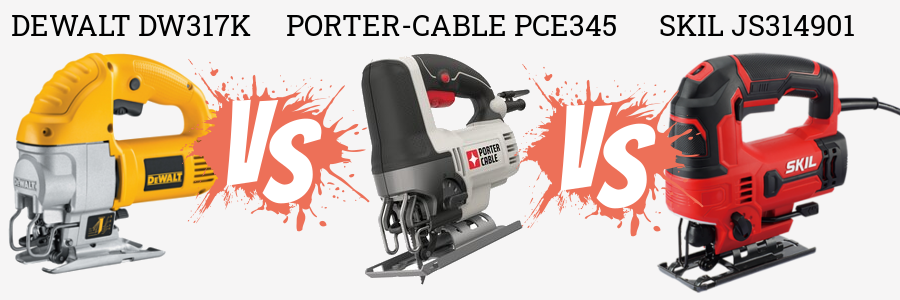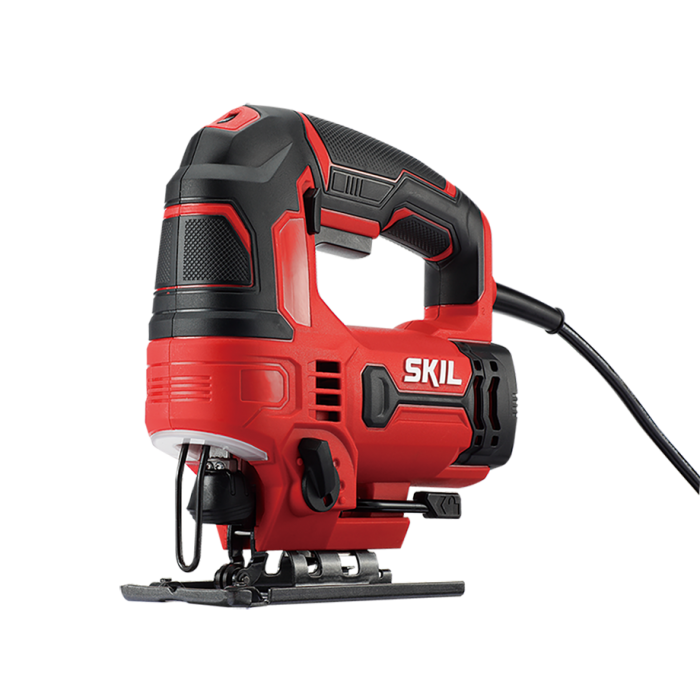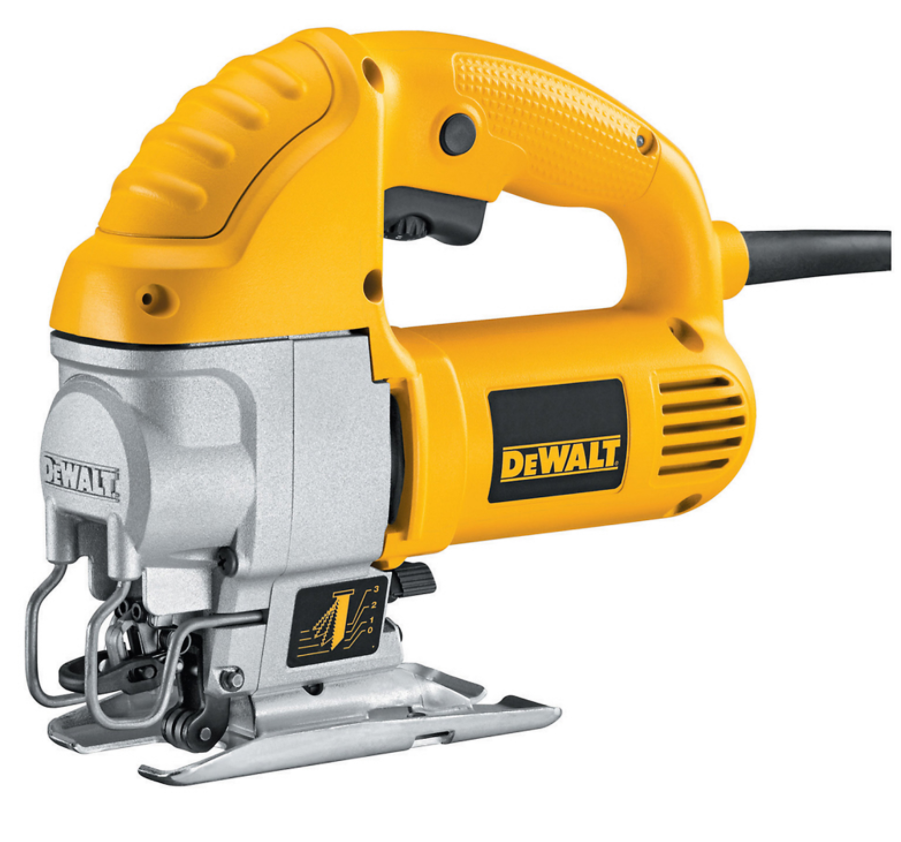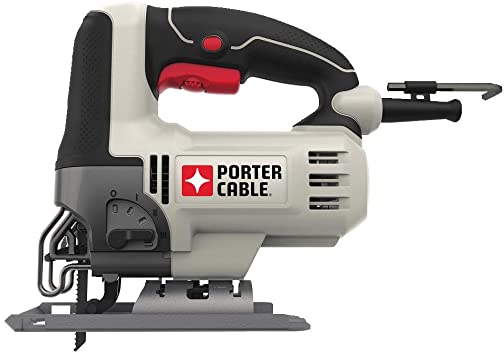
Jig saws are some of the most versatile tools in the shop. They are best suited for curves or other free-hand cuts. The reciprocating (up-and-down) blades can cut wood, metal, plastic, drywall, fiberglass, and everything in between. In short, jig saw are the only handheld power tool that can cut curves.
They can cut straight lines as well. That’s dependent upon the steadiness of your hand or a straight-edge guide that you’re cutting against.
You need a jig saw for curves. You also need a jig saw for quick cuts that don’t need to be dead accurate but need to be fast. Jig saws can make cross cuts (cutting a board in half), rip cuts (cutting a board down the middle), or curved cuts. One jig saw can cut may different materials; the only thing that has to change is the blade.
Jig saw blade packs usually come with a variety of blades for different cuts and materials. Thinner blades are better for curves and wider blades are better for straight lines. Coarse-toothed blades are better for wood while fine-toothed blades handle metal better.
Jig saws also benefit from their portability. Instead of having to bring your work to the tool, you can bring your tool to the work. This is helpful for large or unwieldy pieces that are difficult to move or are already installed.
They can make pretty much any cut, but they will be rough cuts. Jig saws are popular due to their versatility. While dead straight cuts would require a circular saw or table saw, a decently straight cut can be achieved with a jig saw.
The Quick Answer
Each jig saw has its strengths and any of these saws would fit well in any garage workshop. But we’ll give one-liner summaries for each saw that can hopefully guide you to which one best serves your needs:
- If you’re intrigued by the dust blower and light at a low price, give the SKIL JS314901 a serious look.
- If you’re looking for a no-frills, rock solid jig saw, check out the DEWALT DW317K.
- If you want the standard weekend warrior jigsaw at a great price, the PORTER-CABLE PCE345 will fit your bill nicely.
SKIL JS314901
SKIL’s JS314901 delivers standard power for the saw class. It’s an affordable solution for most cutting operations, including wood and metal. When looking for blades for this saw, make sure you purchase u-shank blades.
The footplate pivots to allow 45-degree cuts and is locked and unlocked via a bevel lever. Four orbital settings control the aggressiveness of the cut.
SKIL includes two welcome features in this jigsaw: a blower and a light. The blower keeps the blade area free of sawdust and the light keeps the kerf and cutline well-lit. The combination of these two features does wonders to maximize visibility while cutting.
One functionality that we don’t prefer is the variable speed mechanism. Most variable speed saws use the trigger as the speed limiter (i.e. lightly press the trigger for slow speeds and firmly press the trigger for faster speeds). The JS314901 uses a speed dial to set the speed. The trigger is binary, so you can’t sneak up on the speed you want or easily adjust mid-cut.
DEWALT DW317K
The DW317K from DEWALT is a sturdy and well-built jig saw. There’s more metal in this saw than any of the competitors. That adds some weight, but that’s a good thing for a jig saw in our opinion. If the saw blade catches the wood in a weird way, the saw is less prone to jerking up off the workpiece.
A four-position blade setting sets the aggressiveness of the cut. Note that this saw uses t-shank blades. The footplate pivots to 45 degrees and is locked with an ubobstructive lever on the back of the saw’s body.
We don’t find many extra features with the DW317K. There’s no work light or blower, but those are uncommon features in this saw category at these price points.
PORTER-CABLE PCE345
PORTER-CABLE’s PCE345 is a great entry-level. It includes everything you need at a compelling price.
The variable speed is limited by a dial and the trigger includes a trigger lock that sets you in cruise control for longer jobs. The footplate can articulate to the normal 45 degrees for mitered cuts.
The PORTER-CABLE can use both t-shank and u-shank blades, which is useful if you have an assortment jig saw blades. The saw includes a four-position orbital lever to control the blade’s pitch (i.e. aggressiveness). The stroke is a tad shorter than the industry standard but it shouldn’t present a problem for the majority of jobs.
So Which Jig Saw is the Best for Your Shop?
We’ve spent some time briefly reviewing each of these jig saws and now we’re pitting them against each other to determine which jig saw is the best bang for your buck. These saws represent the entry-level corded category with their light weight, moderate power, and affordable prices.
Full reviews for each tool can be found here:
Scoring will be based on each saw’s performance in four categories. Also, units can score equally if deserved in a particular category (e.g. a first, second, third, etc isn’t forced). For this comparison, the max score possible is set at 100 and the minimum score is 20.
Which Jig Saw Offers the Most Power?
Exemplary = 25 points
Satisfactory = 15 points
Below Average = 5 points
Jig saws in this category are typically lighter on power, so any extra amps can make a huge difference. That being said, all three saws are fairly comparable with power output. At 5.5 amps, the DEWALT is slightly under the other two but we didn’t notice a difference and we don’t think you will either. Speed is also very comparable among the three saws in the 3,100-3,200 spm range.
Remember, power means nothing if the saw has the wrong blade inserted. Check each review page for blade specifics. Here’s a t-shank set and a u-shank set that we like.
DEWALT, PORTER-CABLE, and SKIL earn 15 points each.
Which Jig Saw is the Sturdiest?
Exemplary = 25 points
Satisfactory = 15 points
Below Average = 5 points
The PORTER-CABLE and SKIL are constructed from a mix of plastic and metal. Obviously, the footplate is metal, but we wish more metal was included elsewhere. Both are respectable though and weigh around 5 lbs, which is average for this saw class.
The DEWALT is noticeably more solid. Metal abounds in this jig saw and we like that the business end of the tool incorporates a 100% metal gear case. At 6 lbs, the DEWALT weighs a pound heavier than the others, which reduces tool chatter significantly.
DEWALT earns 25 points, SKIL and PORTER-CABLE earns 15 points.
Which is the Best Saw from a Features Standpoint?
Exemplary = 25 points
Satisfactory = 15 points
Below Average = 5 points
Features can make or break the light jig saw category and this comparison is no exception. All three saws incorporate the basics: variable speed, trigger locks, pivoting footplates, and four-position orbital adjustments.
The SKIL is the controversial saw of the bunch. It performs some things well and others not so much. We particularly like two features not included on the other saws: a light and a blower. The halo light surrounds the blade and keeps your work illuminated. The blower keeps the area dust free. Jig saws cut on the up-motion, so dust tends to collect right where you least want it: on the cut line. The blower + light combination is incredibly handy and would earn the SKIL the top spot in this category except for our one major gripe: the trigger.
While the other saws use true variable triggers that can be partially or fully depressed, the SKIL’s trigger is binary. It’s either full on or fully off. The variable speed dial controls the speed but your blade is fully committed once you press the trigger. While this may not be a big deal to some, we feel that a lot of value is lost here with the exclusion of this standard functionality.
The PORTER-CABLE includes all the standard features. It accepts both u-shank and t-shank jig saw blades which is handy if you have a grab bag assortment of blades. The variable speed dial is located on the trigger, which is a bit strange but doesn’t present any issues.
The DEWALT is the standard, no-frills saw in this group. It has everything you need but maybe missing some things you’d want like a light or blower. The features it does have perform as expected.
DEWALT, PORTER-CABLE, and SKIL earn 15 points each.
Which Jig Saw is Priced the Lowest?
Exemplary = 25 points
Satisfactory = 15 points
Below Average = 5 points
Last time we did a price check, the SKIL and PORTER-CABLE were both around $50 (plus or minus $10). This is a pretty competitive price for both saws, especially considering the extra features that come on the SKIL.
At around $100, the DEWALT comes in at double the price of the other two. The only reason we could see behind this price point is the extra metal in the body’s construction; however, there aren’t any special features on the DEWALT so we think it should have a lower price tag.
SKIL and PORTER-CABLE earn 15 points, DEWALT earns 5 points.
Final Results
We’ve come to a contentious three-way tie from a point tally perspective. Our comparison has to take a qualitative approach and look at the individual strengths of each jig saw. Each of these saws has a place in the garage workshop, so consider the strengths below to determine which saw will be your best bet:
- If you see a big value-add in the dust blower and light at a low price, consider the SKIL JS314901.
- If you just want a sturdy, quality unit without the extra features, check out the DEWALT DW317K.
- If you’re looking for your first saw and don’t want to spend much, take a look at the PORTER-CABLE PCE345 since it includes everything you need.



